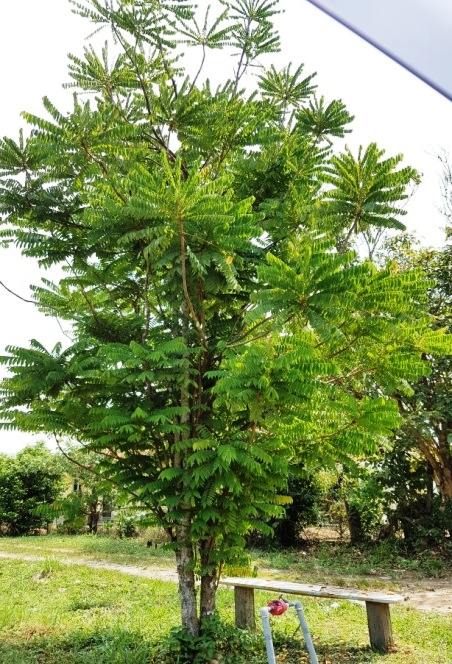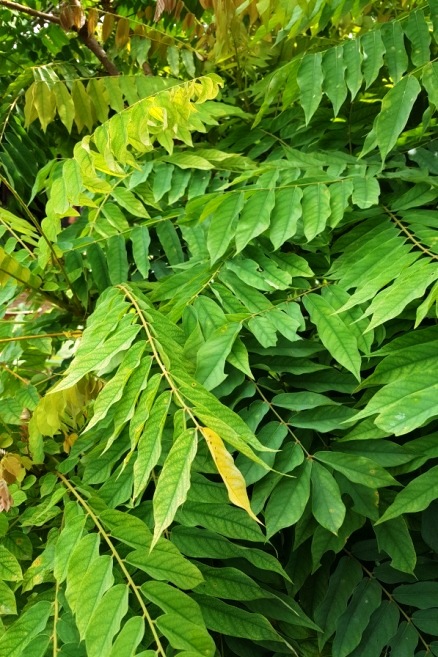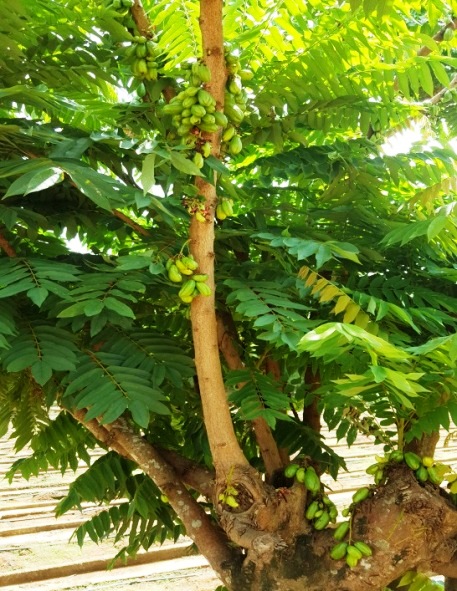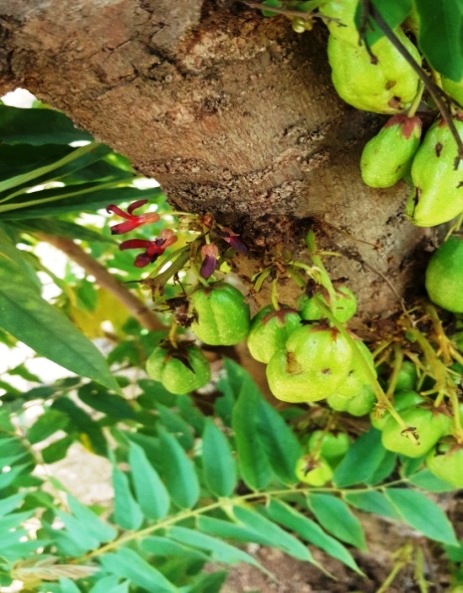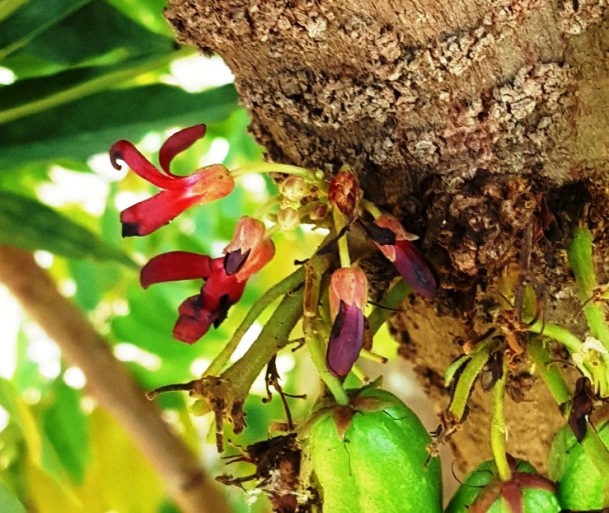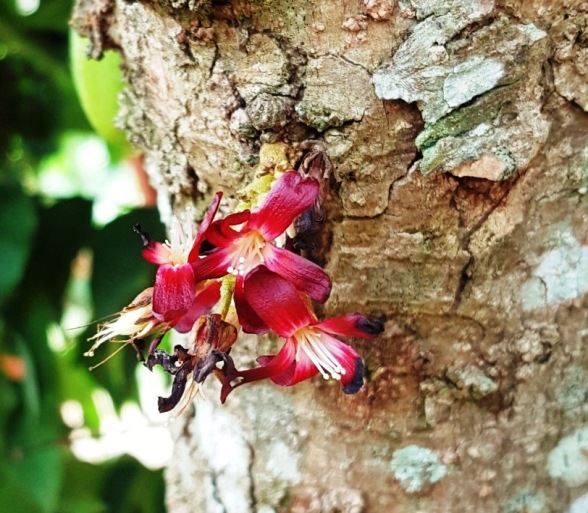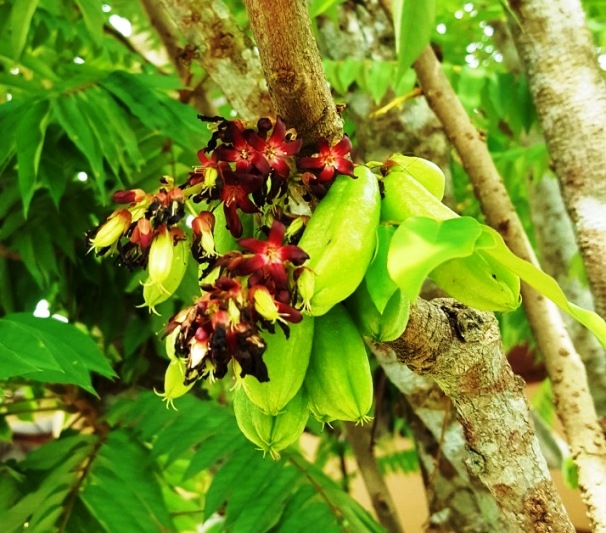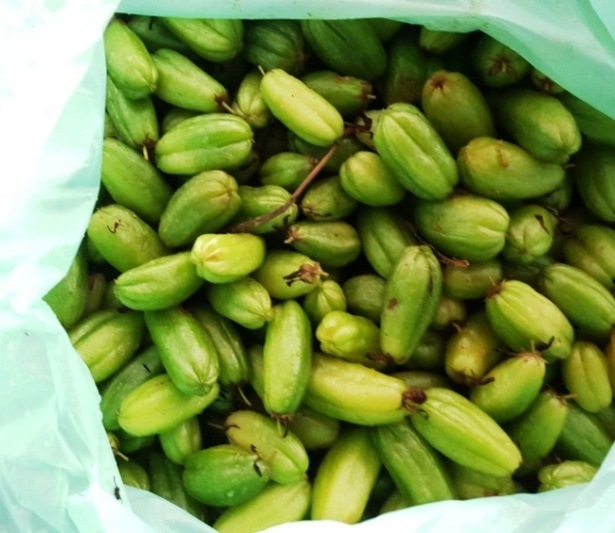Belimbing buluh Fruit
Averrhoa bilimbi Linn.
Oxalidaceae
DEFINITION
Belimbing buluh fruit consists of the powder of dried fruit of A. bilimbi Linn. (Oxalidaceae).
SYNONYM
Averrhoa abtusangulata Stokes, Averrhoa obtusangula Stokes [ 1 ].
VERNACULAR NAMES
Cucumber tree, tree sorrel, bilimbi (English); belimbing, belimbing buloh, blimbing asam, belimbing buluk, bilimbing wuluh, billing billing (Malay); yang tao (Chinese); bilimbi (Tamil)
[ 2 , 3 , 4 ].
CHARACTER
| Colour | Dark brown |
| Odour | Characteristic |
| Taste | Acidic and sour |
IDENTIFICATION
Plant Morphology
A. bilimbi is a perennial tree up to 5–10 m in height; has a short trunk soon dividing into a number of upright branches. Leaves 30–60 cm long, mainly clustered at the branch tips, alternate, imparipinnate with 11–37 alternate or sub opposite leaflets; leaflet ovate or oblong, with rounded base and pointed tip, downy, medium-green on the upper surface, pale on the underside, 2-10 cm long, 1.2–1.25 cm wide. Inflorescence borne in small, hairy panicles emerging directly from the trunk and oldest, thickest branches and some twigs. Flowers small, fragrant; petals 5, yellowish-green or purplish marked with dark-purple, 10–30 mm long. Fruits ellipsoid, obovoid or nearly cylindrical, faintly 5-sided, 4–10 cm long; capped by a thin, star-shaped calyx at the stem-end and tipped with 5 hair-like floral remnants at the apex; fruit is crisp when unripe, turns from bright-green to yellowish green when ripe, ivory or nearly white when matured and falls to the ground; outer skin is glossy, very thin, soft and tender, and the flesh green, jelly-like, juicy and extremely acid. Seeds flattened, smooth, disc-like seeds, about 6 mm length, few (perhaps 6 or 7) and brown in colour [ 4 , 5 , 6 , 7 ].
Microscopy
Powdered material consists of simple, unicellular trichome, oil cells, druse calcium oxalate crystals, and spiral vessel.
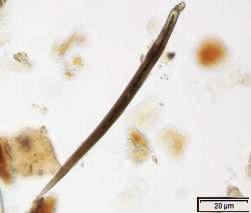
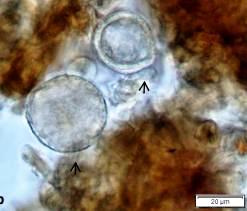
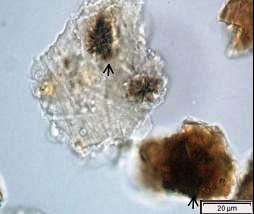
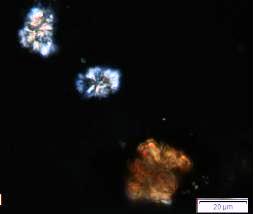

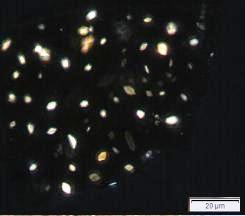
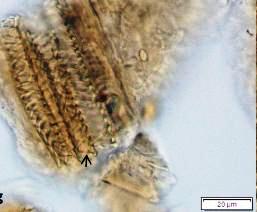
Figure 2 : Microscopic characters of A. bilimbi dried fruit powder of 0.355 mm size. (a) Simple, unicellular trichome (magnification 40x); (b) oil cells (arrow) (magnification 40x); (c) druse calcium oxalate crystals (arrow) (magnification 40x); (d) druse calcium oxalate crystals, under polarised filter (magnification 40x); (e) solitary calcium oxalate crystals (arrow) (magnification 40x); (f) solitary calcium oxalate crystals, under polarised filter (magnification 40x); (g) spiral vessel (arrow) (magnification 40x). [Scale bars: a – h = 20 µm].
Chemical Tests
Observation of solution after treatment with various reagents:
| Test for the presence of phenolic | Positive |
| Test for the presence of flavonoid | Positive |
| Test for the presence of saponins | Positive |
Thin Layer Chromatography (TLC)
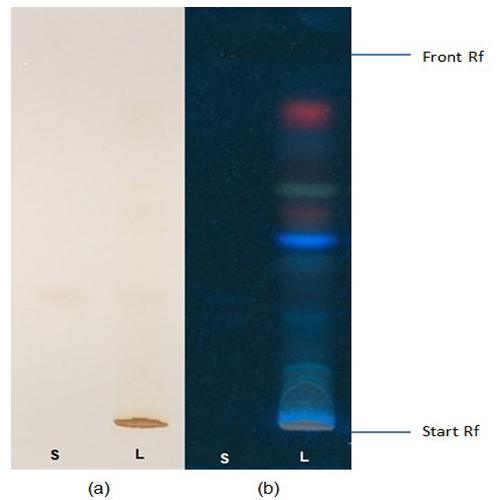
Figure 3: TLC chromatogram of catechin (S) and methanol extract of A. bilimbi dried fruit powder (L) observed under (a) UV at visible light after derivatisation, and (b) UV at 366 nm after derivatisation.
| Test Solutions | Weigh about 4.0 g of A. bilimbi dried fruit powder of 0.355 mm size in a 50 mL round bottom flask. Add 20 mL of methanol and shake gently for 1 min and then, reflux for next 20 min. Turn off the reflux and allow to cool at room temperature. Filter the mixture with filter paper into round bottom flask. Use the filtrate as test solution. |
| Standard solution | Dissolve catechin standard [CAS no.: 225937-10-0] in methanol to produce a standard concentration of 0.1 mg/mL. |
| Stationary Phase | HPTLC glass silica gel 60 F254, 10 x 10 cm |
| Mobile phase | Toluene : ethyl acetate : formic acid; (5 : 4 : 1) (v/v/v) |
| Application |
|
| Development distance | 8 cm |
| Drying | Air drying |
| Detection |
UV at 366 nm and visible light after derivatisation with 1% methanolic solution of natural product reagent and heat at 105˚C for 5 min. |
High Performance Liquid Chromatography (HPLC)
| Test solution | Weigh about 1.0 g of A. bilimbi dried fruit powder of 0.355 mm size in a conical flask. Add 8 mL of 50% methanol and immerse into the ultrasonic bath at 30°C for 30 min. Centrifuge the extract for 15 min and filter the solution through a 0.45 µm syringe filter and inject the filtrate into the HPLC column. Use the filtrate as test solution. | ||||||||||||||||||
| Standard solution | Dissolve catechin standard [CAS no.: 225937-10-0] in methanol to produce a standard concentration of 0.1 mg/mL. | ||||||||||||||||||
| Chromatographic system |
Detector: UV 280 nmColumn: C18 (5.0 µm, 4.6 mm I.D x 250 mm) (Luna if necessary) Column oven temperature: 35°C Flow rate: 1.0 mL/min Injection volume: 10.0 µL |
||||||||||||||||||
| Mobile Phase (gradient mode) |
|
||||||||||||||||||
| System suitability requirement |
Perform at least five replicate injections of the standard solutions (0.1 mg/mL). The requirements of the system suitability parameters are as follow:
|
||||||||||||||||||
| Acceptance criteria |
|

(a)

(b)
Figure 4 : Whole HPLC chromatogram of (a) catechin standard solution (0.1 mg/mL) at tr = 5.043 min and (b) methanol extract of A. bilimbi dried fruit powder showing peak corresponding to catechin standard solution at tr = 5.040 min.

(a)

(b)
Figure 5: HPLC chromatogram highlighting the eluting region of (a) catechin standard solution (0.1 mg/mL) at tr = 5.043 min and (b) methanol extract of A. bilimbi dried fruit powder showing peak corresponding to catechin standard solution at tr = 5.040 min.

Figure 6: UV spectrum of catechin standard solution (0.1 mg/mL) and methanol extract of A. bilimbi dried fruit powder.
PURITY TESTS
The purity tests, except foreign matter test are based on A. bilimbi dried fruit powder of 0.355 mm particle size.
| Foreign Matter |
| Not more than 2% |
| Ash Contents | |
| Total ash | Not more than 7% |
| Acid-insoluble ash | Not more than 1% |
| Loss on Drying |
| Not more than 15% |
| Extractive Values | |
| Water-soluble extracts | |
| Hot method | Not less than 40% |
| Cold method | Not less than 35% |
| Ethanol-soluble extracts | |
| Hot method | Not less than 19% |
| Cold method | Not less than 19% |
SAFETY TESTS
The safety tests are based on A. bilimbi dried fruit powder of 0.355 mm particle size.
| Heavy Metals | |
| Arsenic | Not more than 5.0 mg/kg |
| Mercury | Not more than 5.0 mg/kg |
| Lead | Not more than 10.0 mg/kg |
| Cadmium | Not more than 0.3 mg/kg |
| Microbial Limits | |
| Total bacterial count | Not more than 105 cfu/g |
| Total yeast and mould count | Not more than 104 cfu/g |
| Bile-tolerant gram negative | Not more than 104 cfu/g |
| Specific Pathogens | |
| Salmonella spp. | Absent in 25 g |
| Escherichia coli | Absent in 1 g |
| Staphylococcus aureus | Absent in 1 g |
| Pseudomonas aeruginosa | Absent in 1 g |
CHEMICAL CONSTITUENTS
Aqueous extract of A. bilimbi fruit reported to contain organic compounds, and fatty acids [ 8 ].
Methanol extract of A. bilimbi fruit was found to contain alkaloids, carbohydrates, phenols, flavonoids, saponins and tannins [ 9 ].
Methanol (50%) extract of A. bilimbi fruit reported to contain flavonoids (catechin) [ 10 ].
Dichloromethane extraction of A. bilimbi fruit reported to contain phenolics, fatty acids, terpenes, and organic esters [ 11 ].
Aqueous acetone extract of A. bilimbi fruit reported to contain proanthocyanidins, tannins, flavonoids (e.g. procyanidins, catechin, epicatechin) [ 12 ].
Aqueous acetone (7 : 3) extract of A. bilimbi fruit was found to contain flavonoids (e.g. catechin, epicatechin, and epicatechin–benzyl mercaptan)[ 13 ].
Diethyl ether extraction of A. bilimbi fruit reported to contain phenolics, terpenes, saponins and fatty acids [ 14 ].
MEDICINAL USES
Uses described in folk medicine, not supported by experimental or clinical data
The fruit of A. bilimbi is traditionally prepared with pepper and is taken to promote perspiration. Its pickled fruit in form of paste is applied to whole body after a continuous fever and gout. The juice of the fruit is dropped into the eyes for eye problems and as a drink to act as cooling agent during fever. Meanwhile, its leaves are applied to reduce itching. Its leaves infusion is taken after childbirth and for coughs. Decoction of the leaves are taken for inflammation of the rectum. Its leaves in paste form are applied for mumps, joint pain and pimples. Its flower infusion is taken for cough and thrush. Its grated fruits are applied on pimples [ 15 , 16 ].
Biological and pharmacological activities supported by experimental data
Antimicrobial activity
Methanol extract of A. bilimbi fruit (400 μg/disc) inhibited the growth of Staphylococcus aureus (18 mm), Bacillus megaterium (19 mm), B. subtilis (18 mm), Sarcina lutea (18.5 mm),Salmonella paratyphi (23 mm), Salmonella typhi (20 mm), Escherichia coli (19 mm), Shigella dysenteriae (20 mm), compared to kanamycin (30 µg/disc) control (25 mm, 30 mm, 32 mm, 28 mm, 30 mm, 33 mm, 32 mm and 28 mm) using disc diffusion method [ 17 ].
Aqueous extract of A. bilimbi fruit (50 mg/mL; 100 mg/mL) inhibited the growth of S. aureus (8 mm; 10 mm), S. epidermis (7 mm; 8 mm), Bacillus cereus (10 mm; 13 mm) and Kocuria rhizophila (12 mm; 13 mm) compared to amphicillin (30 mg/mL; S. aureus (12 mm), S. epidermis (12 mm), Bacillus cereus (11 mm) and Kocuria rhizophila (16 mm) and kanamycin (30 mg/mL; S. aureus (12 mm), S. epidermis (12 mm), Bacillus cereus (22 mm) and Kocuria rhizophila (25 mm)) using disc diffusion method [ 18 ].
Chloroform extract of A. bilimbi fruit (100 mg/mL) inhibited the growth of S. aureus (10 mm), S. epidermis (9 mm), K. rhizophila (20 mm) and Corynebacterium diphtheria (10 mm) compared to amphicillin (30 mg/mL; S. aureus (12 mm), S. epidermis (12 mm), C. diphtheria (15 mm) and K. rhizophila (16 mm)) and kanamycin (30 mg/mL; S. aureus (12 mm), S. epidermis (12 mm), C. diphtheria (16 mm) and K. rhizophila (25 mm) using disc diffusion method [ 18 ].
Antioxidant activity
Methanol extract of A. bilimbi fruit showed antioxidant activity with 50% inhibition concentration (IC50) of 53.71 µg/mL compared to L-Nitro-Arginine Methyl Ester (IC50 = 39.11 µg/mL) using nitrite assay [ 19 ].
Methanol extract of A. bilimbi fruit showed antioxidant activity with IC50 of 55.07 µg/mL compared to curcumin (IC50 = 99.35 µg/mL) using reactive oxygen species radical scavenging assay [ 20 ].
Antidiabetic activity
Ethyl acetate fraction of A. bilimbi fruits (25 mg/kg body weight) was administered orally to the diabetic two-month-old male Sprague Dawley rats (200 – 220 g body weight) by intragastric intubation once daily in the morning after food delivery for 60 days significantly (p < 0.05) decreased blood glucose (148.63 ± 5.53 mg/dL) in diabetic rats compared to diabetic metformin group (100 mg/kg body weight; 155.80 ± 5.80 mg/dL) [ 21 ].
Clinical studies
Information and data have not been established.
SAFETY INFORMATION
Preclinical studies (Toxicology studies)
Acute toxicity
Oral single dose acute toxicity study on female Sprague Dawley rats (aged between 8 and 12 weeks old) using aqueous extract of A. Bilimbi fruits showed no toxic effect on the parameters observed, including behaviours, body weight, food and water intake. All rats were observed for 14 days prior to necropsy. No death was found throughout the study period. Necropsy revealed no significant abnormality. Half lethal dose (LD50) is not more than 2,000 mg/kg body weight [ 22 ].
Others (Adverse reaction, contraindication, side effect, warning, precaution)
Information and data have not been established.
DOSAGE
Information and data have not been established.
STORAGE
Store below 30°C. Protect from light and moisture.
REFERENCES
- The Plant List. [Internet] Averrhoa bilimbi L; 2012. (cited on 10th Aug 2018). Available from http://www.theplantlist.org/tpl1.1/record/kew-2666745.
- Umberto Quattrocchi FLS. Averrhoa bilimbi In: CRC World Dictionary of Medicinal and Poisonous Plants, FLS Umberto Quattrocchi, Ed., vol. 1 A-B, Florida: CRC Press, 2012, p. 493-494.
- Morton J. Belimbi, In: Fruits of Warm Climates, JF Morton, Ed, Miami, Florida, 1987, pp. 128-129.
- Orwa C, Mutua A, Kindt R, Jamnadass R, Anthony S. Agroforestree Database: A tree reference and selection guide version 4.0. 2009. Available from http://www.worldagroforestry.org/treedb/AFTPDFS/Averrhoa_bilimbi.PDF. [Cited on 17th Oct 2018].
- Saini S. A review on phytochemistry and pharmacology of Averrhoa bilimbi International Education and Research Journal. 2016;2:71-76.
- Kumar KA, Gousia S, Anupama M, Latha JNL. A review on phytochemical constituents and biological assays of Averrhoa bilimbi. International Journal of Pharmaceutical Sciences and Research. 2013;3(4):136-139.
- NParks Flora and Fauna. [Internet] Averrhoa bilimbi L; (cited on 10th Aug 2018). Available from https://florafaunaweb.nparks.gov.sg/special-pages/plant-detail.aspx?id=2735.
- Kurup SB, Mini S. Protective potential of Averrhoa bilimbi fruits in ameliorating the hepatic key enzymes in streptozotocin-induced diabetic rats. Biomedicine & Pharmacotherapy. 2017;85:725-732.
- Jagadish KS, Berlin VMG. Phytochemical profile and free radical nitric oxide (NO) scavenging activity of Averrhoa bilimbi fruit extract. 3 Biotech 2017;7(85):1-11.
- Muhamad N, Yusoff MM, Gimbun J. Thermal degradation kinetics of nicotinic acid, pantothenic acid and catechin derived from Averrhoa bilimbi Royal Society of Chemistry Advances. 2015; 5:74132-74137.
- Wong KC, Wong SN. Volatile constituents of Averrhoa bilimbi fruit. Journal of Essential Oil Research. 1995;7(6):691-693.
- Ramsay A, MuellerHarvey I. Procyanidins from Averrhoa bilimbi fruits and leaves. Journal of Food Composition and Analysis 2016;16:16-20.
- Ramsay A, MuellerHarvey I. Proanthocyanidins from Averrhoa bilimbi fruits and leaves. Journal of food composition and analysis. 2016;47:16-20.
- Pino JA, Marbot R, Bello A. Volatile components of Averrhoa bilimbi fruit grown in Cuba. Journal of Essential Oil Research 2004;16(3):241-242.
- Burkill IH. (1935) A dictionary of the economic products of the Malay Peninsula. Crown Agents, London.
- Ong H, Nordiana M. Malay ethno-medico botany in Machang, Kelantan, Malaysia. Fitoterapia. 1999;70(5):502-513.
- Das SC, Sultana S, Roy S, Hasan SS. Antibacterial and cytotoxic activities of methanolic extracts of leaf and fruit parts of the plant Averrhoa bilimbi (Oxalidaceae). American Journal of Scientific and Industrial Research. 2011;2(4):531-536.
- Zakaria ZA, Henie E, Jais M, Manan A, Zainudin E, Huda EN. In vitro antibacterial activity of Averrhoa bilimbi leaves and fruits extracts. International Journal of Tropical Medicine. 2007;2(3):96-100.
- Rahman MM, Habib MR, Hasan MA, Al Amin M, Saha A, Mannan A. Comparative assessment on in vitro antioxidant activities of ethanol extracts of Averrhoa bilimbi, Gymnema sylvestre and Capsicum frutescens. Pharmacognosy research. 2014;6(1):36.
- Francis A, Nayak Y. Modulation of doxorubicin-induced cardiotoxicity by Averrhoa bilimbi Journal of Young Pharmacists. 2017;9(1):70-78.
- Kurup SB, Saraswathy M. Averrhoa bilimbi fruits attenuate hyperglycemia-mediated oxidative stress in streptozotocin-induced diabetic rats. Journal of Food and Drug Analysis. 2016;25(2):360-368.
- Elda Nurafnie IR, Nor Azlina Z, Hemahwathy CK, Farah Huda M, Izwah H, Teh BP. Acute oral toxicity study of selected Malaysian medicinal herbs on Sprague Dawley rats. Institute for Medical Research, Ministry of Health; 2019. report no.: NON-GLP/2019/10/01.

